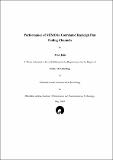Please use this identifier to cite or link to this item:
http://drsr.daiict.ac.in//handle/123456789/70| Title: | Performance of MIMO in correlated rayleigh flat fading channels |
| Authors: | Jadhav, Ashish Jain, Alok |
| Keywords: | Antenna Communication system MIMO Communication system MIMO Multiple Input Multiple Output |
| Issue Date: | 2005 |
| Publisher: | Dhirubhai Ambani Institute of Information and Communication Technology |
| Citation: | Jain, Alok (2005). Performance of MIMO in correlated rayleigh flat fading channels. Dhirubhai Ambani Institute of Information and Communication Technology, vii, 49 p. (Acc.No: T00033) |
| Abstract: | The recent interest in Multiple Input Multiple Output (MIMO) communication systems was initiated by the theoretical work of Telatar. The development in the field of random matrix theory is the basis of these studies. The assumption in the mathematical model for studying MIMO turned out to be too idealistic for realistic (correlated) channel condition. This lead to an exaggeration of performance of MIMO. This thesis deals with quantification of performance of MIMO in realistic channel conditions with the emphasis on study of working of MIMO receivers. Our definition of MIMO contains both diversity systems and spatial multiplexing systems. For the simulation of realistic channel conditions a correlated fading channel model with lack of rich scattering is used. To perform simulations for N transmit and M receive MIMO systems there is a need for having N x M correlated fading envelops. We propose a novel and simplified technique to extend the algorithm for two correlated fading envelops given by Richard and Jeffery. Various analytical studies on the effect of correlated multi-path channel on performance of spatial multiplexing have been done. These studies focus on capacity cumulative distribution function. Effect of various degree of correlation on other performance measures like diversity gain and error probability have been not done. This is due to lack of simple method of generation of correlated Rayleigh fading envelops. By making use of the extended algorithm we have been successful in carrying out simulation to observe the effects on the performance. Recently there is interest in extending the concept of MIMO in wireless communication for sensor networks. The motivation behind it is energy efficiency of sensor nodes. Our results have implications on this venture. |
| URI: | http://drsr.daiict.ac.in/handle/123456789/70 |
| Appears in Collections: | M Tech Dissertations |
Files in This Item:
| File | Description | Size | Format | |
|---|---|---|---|---|
| 200311002.pdf Restricted Access | 415.47 kB | Adobe PDF |  View/Open Request a copy |
Items in DSpace are protected by copyright, with all rights reserved, unless otherwise indicated.
